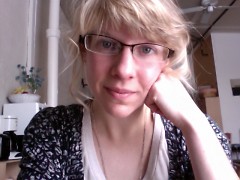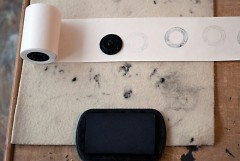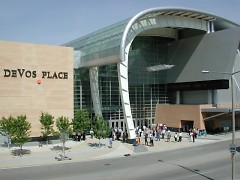Ever since high school, I’ve known Courtney Jones to be a Jack (or rather, Jill) of all trades. She has always found enduring ways to perpetuate the use of a functional body, whether in work, school or recreation. Over the years, she has held the roles of artist, student, triathlete, philosopher, and most recently, curator. For Art.Downtown. 2015, Jones will be curating a show titled “Forms of Production” at the DeVos Place in Grand Rapids, themed around concepts of work and production and how those things affect the worker. She has selected artists for this exhibition whose works challenge the misperceptions of what constitutes work, what products merit value, and the ongoing clash centered around form versus function.
Curating extraordinary shows is not something new to Jones. She doesn’t necessarily differentiate between being an artist and a curator. Jones graduated from Grand Valley State University in 2013 with a degree in Visual Studies and concentrations on video, performance and sculpture. She has participated in a number of public events such as SiTE:LAB and Art.Downtown. With previous works based on the systems of growth and decay within a body (or form), the Forms of Production exhibition has taken on a new exploration of the relationship between the production of forms and how that production affects the individual. Recently I sat down to find out more about Jones, and her view on curating.
“There’s always challenges and technicalities to a show. I focus on what is required to make a show good. I am still very interested in exploring how things form and how they break down, so I think this show just takes it into a more ambiguous social perspective,” says Jones. By taking on the role of curator Jones says she is able to witness the dialogue between different artists and their works. Forms of Production allows the viewer to interpret the theme for themselves and form a dialogue about what makes work valuable and why. For Jones, this question is one that most, if not all, artists and makers ask themselves at some point in their practice, especially those who are just getting out of college.
“I’m a fresh college grad,” Jones explains, “so there’s a search for validity put on me, something that is ‘useful’. I have a desire to validate myself as an artist.”
As a city with a rich history entwined with furniture design and production, Grand Rapids' core industry is centered around making. While this helps to foster creativity in a spectrum of areas, it may result in an underlying notion that people are nervous around things that they perceive as “useless.” Showing at the DeVos Place solidified what Jones' show would be about.
“In my head the work and the space are connected, but I like to leave the visual to the visual and let the dialogue happen between works in the show,” she says. Jones hopes that viewers can think about work and its surroundings.
“Grand Rapids is a city built on production," she adds. "While it might not always have arms wide open, it is nonetheless a great space for ideas to grow. I don’t think it either hurts or helps the show. I do believe that it provides a great foundation for a dialogue on the topic.”
That’s one reason Jones is advocating for new and upcoming forms of production. Some pieces that will be in her show for Art.Downtown. will be more traditional, but the process of production is still represented through many forms.
Jones believes that the idea of work is central to our perception of self. She noted that people take a lot of pride in what they do or make, and that this informs people’s perceptions of themselves. In a way, through the construction of objects or services, people are constructing their own being or form. Jones also thinks that how and what you create are directly tied to the surrounding environment and background.
“I think my show does address how different forms of production or making all contribute to the construction of a person,” Jones says. “This idea definitely affects the psychological states of individuals. More so, defining value affects the construction and perception of self.”
To see more of Courtney’s personal artwork, visit http://courtneyjones.co/. Join her show event on Facebook at https://www.facebook.com/events/1581429915445023/. Find out more about DeVos place at https://devosplace.org/explore. Check out Art.Downtown. at http://avenueforthearts.com/artdowntown/.
The Avenue for the Arts is a neighborhood title for the South Division commercial corridor. We are residential, commercial and nonprofit groups working together in a creative community. We are residents in Heartside, and active participants in shaping change in our neighborhood. In 2005, we chose the Avenue for the Arts as a title to represent our commercial corridor and the projects and events that we create. Because the Avenue is powered by volunteers, guest writers create our Rapidian content. Special thanks to Learning Lab participant Dustin Coon for his contribution to this piece. Dustin works through his self-operated studio to create illustrations, portraits, murals, landscapes, comics, and visual series, among writing, storyboarding and marketing.
The Rapidian, a program of the 501(c)3 nonprofit Community Media Center, relies on the community’s support to help cover the cost of training reporters and publishing content.
We need your help.
If each of our readers and content creators who values this community platform help support its creation and maintenance, The Rapidian can continue to educate and facilitate a conversation around issues for years to come.
Please support The Rapidian and make a contribution today.


